SQLAlchemy: Critical Analysis of its Features and Benefits
VerifiedAdded on 2021/04/21
|9
|1829
|75
Report
AI Summary
This report presents a critical analysis of SQLAlchemy, an open-source SQL toolkit and object-relational mapper (ORM) designed for Python. It explores SQLAlchemy's core features, including its ability to provide developers with the flexibility of SQL and its role in mapping Python classes to database tables. The report delves into the use of SQLAlchemy in the software development process, highlighting its advantages such as defining database schemas, automatic synchronization, and integration with web frameworks. It also examines competing products like SQLObject, Storm, and Django's ORM. Furthermore, the analysis covers the benefits of using SQLAlchemy, such as its fast loading performance and ability to handle database systems. The report also discusses the advantages and disadvantages of SQLAlchemy, providing a comprehensive overview of its strengths and weaknesses.
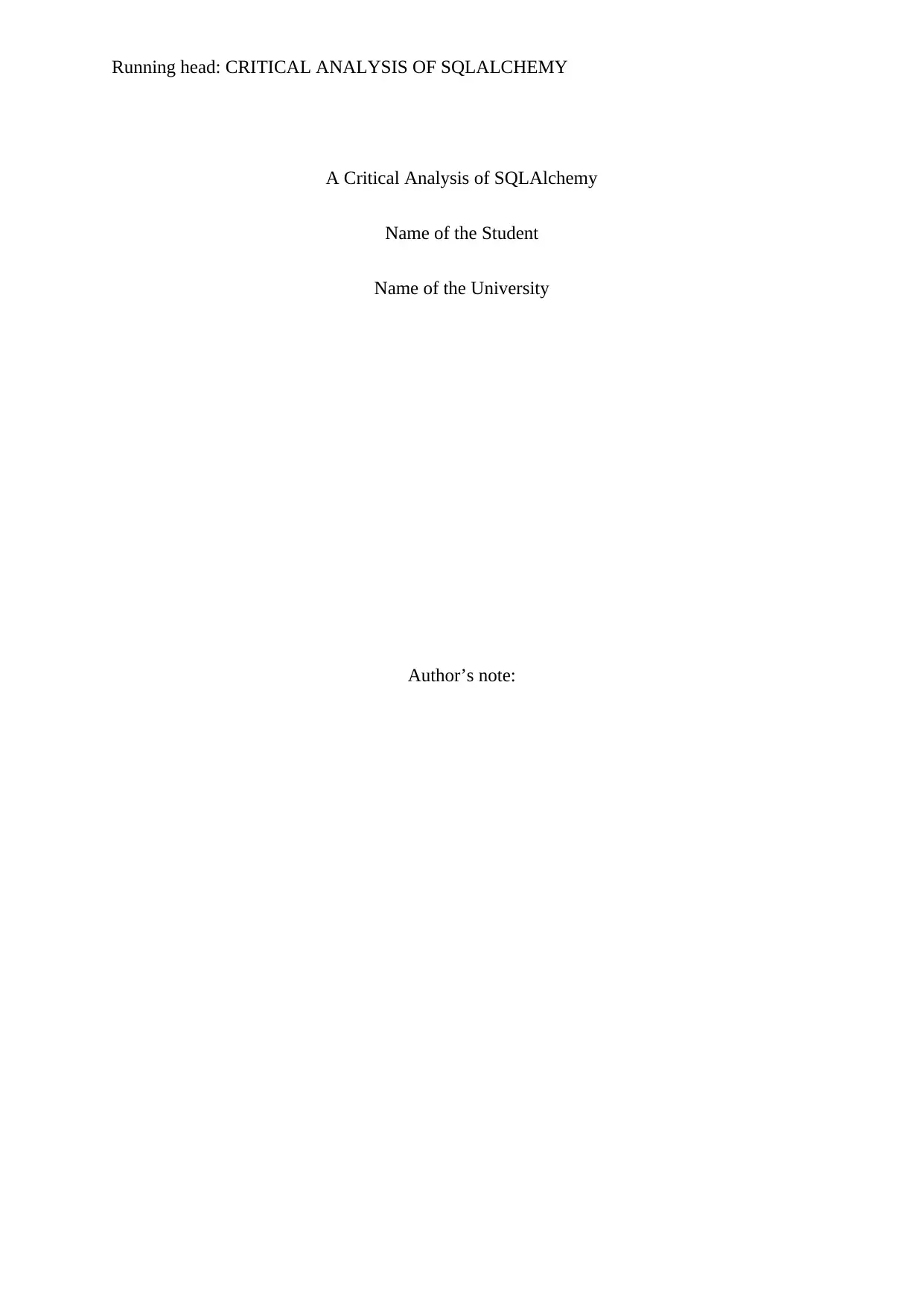
Running head: CRITICAL ANALYSIS OF SQLALCHEMY
A Critical Analysis of SQLAlchemy
Name of the Student
Name of the University
Author’s note:
A Critical Analysis of SQLAlchemy
Name of the Student
Name of the University
Author’s note:
Paraphrase This Document
Need a fresh take? Get an instant paraphrase of this document with our AI Paraphraser
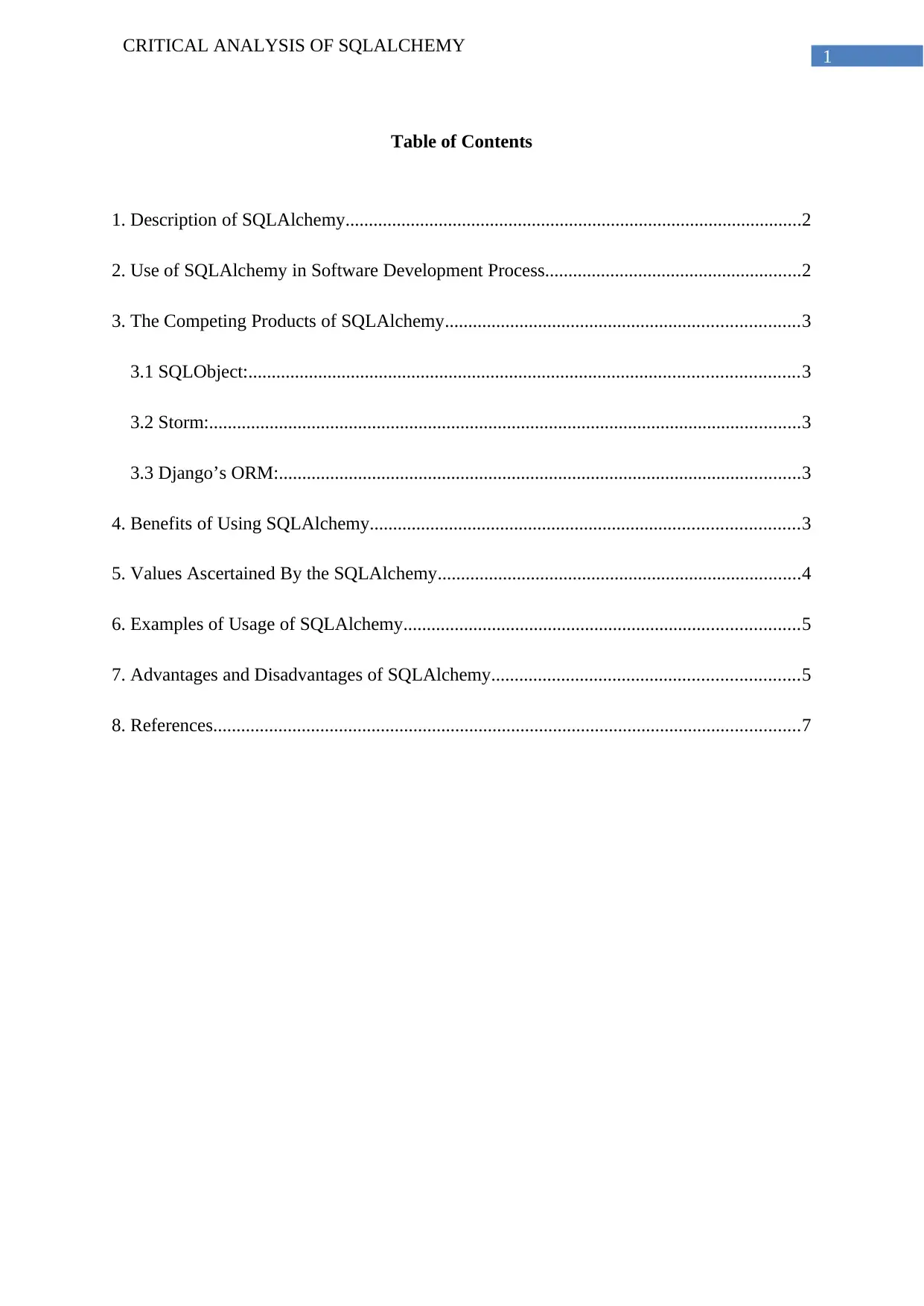
1
CRITICAL ANALYSIS OF SQLALCHEMY
Table of Contents
1. Description of SQLAlchemy..................................................................................................2
2. Use of SQLAlchemy in Software Development Process.......................................................2
3. The Competing Products of SQLAlchemy............................................................................3
3.1 SQLObject:......................................................................................................................3
3.2 Storm:...............................................................................................................................3
3.3 Django’s ORM:................................................................................................................3
4. Benefits of Using SQLAlchemy............................................................................................3
5. Values Ascertained By the SQLAlchemy..............................................................................4
6. Examples of Usage of SQLAlchemy.....................................................................................5
7. Advantages and Disadvantages of SQLAlchemy..................................................................5
8. References..............................................................................................................................7
CRITICAL ANALYSIS OF SQLALCHEMY
Table of Contents
1. Description of SQLAlchemy..................................................................................................2
2. Use of SQLAlchemy in Software Development Process.......................................................2
3. The Competing Products of SQLAlchemy............................................................................3
3.1 SQLObject:......................................................................................................................3
3.2 Storm:...............................................................................................................................3
3.3 Django’s ORM:................................................................................................................3
4. Benefits of Using SQLAlchemy............................................................................................3
5. Values Ascertained By the SQLAlchemy..............................................................................4
6. Examples of Usage of SQLAlchemy.....................................................................................5
7. Advantages and Disadvantages of SQLAlchemy..................................................................5
8. References..............................................................................................................................7
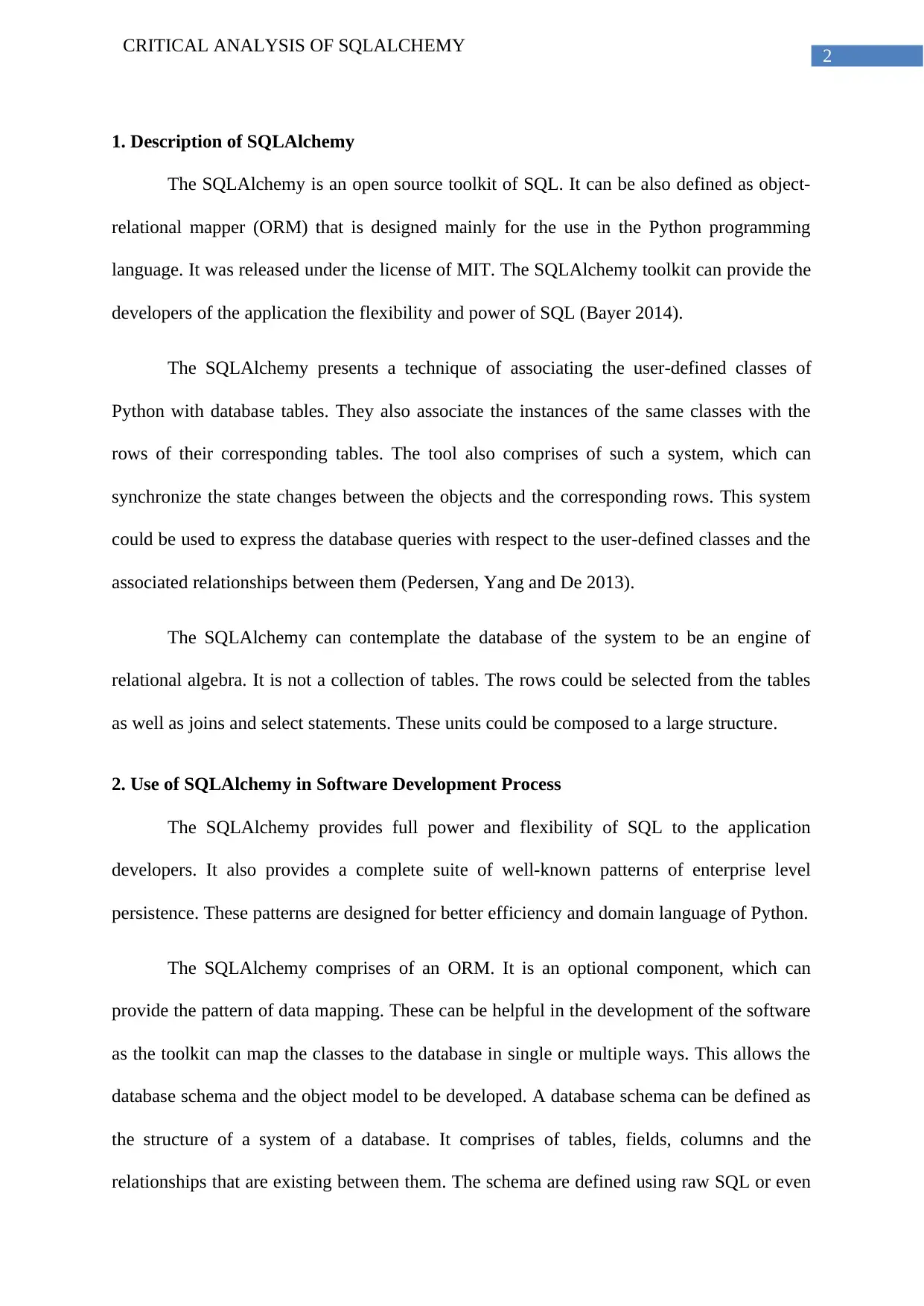
2
CRITICAL ANALYSIS OF SQLALCHEMY
1. Description of SQLAlchemy
The SQLAlchemy is an open source toolkit of SQL. It can be also defined as object-
relational mapper (ORM) that is designed mainly for the use in the Python programming
language. It was released under the license of MIT. The SQLAlchemy toolkit can provide the
developers of the application the flexibility and power of SQL (Bayer 2014).
The SQLAlchemy presents a technique of associating the user-defined classes of
Python with database tables. They also associate the instances of the same classes with the
rows of their corresponding tables. The tool also comprises of such a system, which can
synchronize the state changes between the objects and the corresponding rows. This system
could be used to express the database queries with respect to the user-defined classes and the
associated relationships between them (Pedersen, Yang and De 2013).
The SQLAlchemy can contemplate the database of the system to be an engine of
relational algebra. It is not a collection of tables. The rows could be selected from the tables
as well as joins and select statements. These units could be composed to a large structure.
2. Use of SQLAlchemy in Software Development Process
The SQLAlchemy provides full power and flexibility of SQL to the application
developers. It also provides a complete suite of well-known patterns of enterprise level
persistence. These patterns are designed for better efficiency and domain language of Python.
The SQLAlchemy comprises of an ORM. It is an optional component, which can
provide the pattern of data mapping. These can be helpful in the development of the software
as the toolkit can map the classes to the database in single or multiple ways. This allows the
database schema and the object model to be developed. A database schema can be defined as
the structure of a system of a database. It comprises of tables, fields, columns and the
relationships that are existing between them. The schema are defined using raw SQL or even
CRITICAL ANALYSIS OF SQLALCHEMY
1. Description of SQLAlchemy
The SQLAlchemy is an open source toolkit of SQL. It can be also defined as object-
relational mapper (ORM) that is designed mainly for the use in the Python programming
language. It was released under the license of MIT. The SQLAlchemy toolkit can provide the
developers of the application the flexibility and power of SQL (Bayer 2014).
The SQLAlchemy presents a technique of associating the user-defined classes of
Python with database tables. They also associate the instances of the same classes with the
rows of their corresponding tables. The tool also comprises of such a system, which can
synchronize the state changes between the objects and the corresponding rows. This system
could be used to express the database queries with respect to the user-defined classes and the
associated relationships between them (Pedersen, Yang and De 2013).
The SQLAlchemy can contemplate the database of the system to be an engine of
relational algebra. It is not a collection of tables. The rows could be selected from the tables
as well as joins and select statements. These units could be composed to a large structure.
2. Use of SQLAlchemy in Software Development Process
The SQLAlchemy provides full power and flexibility of SQL to the application
developers. It also provides a complete suite of well-known patterns of enterprise level
persistence. These patterns are designed for better efficiency and domain language of Python.
The SQLAlchemy comprises of an ORM. It is an optional component, which can
provide the pattern of data mapping. These can be helpful in the development of the software
as the toolkit can map the classes to the database in single or multiple ways. This allows the
database schema and the object model to be developed. A database schema can be defined as
the structure of a system of a database. It comprises of tables, fields, columns and the
relationships that are existing between them. The schema are defined using raw SQL or even
⊘ This is a preview!⊘
Do you want full access?
Subscribe today to unlock all pages.

Trusted by 1+ million students worldwide
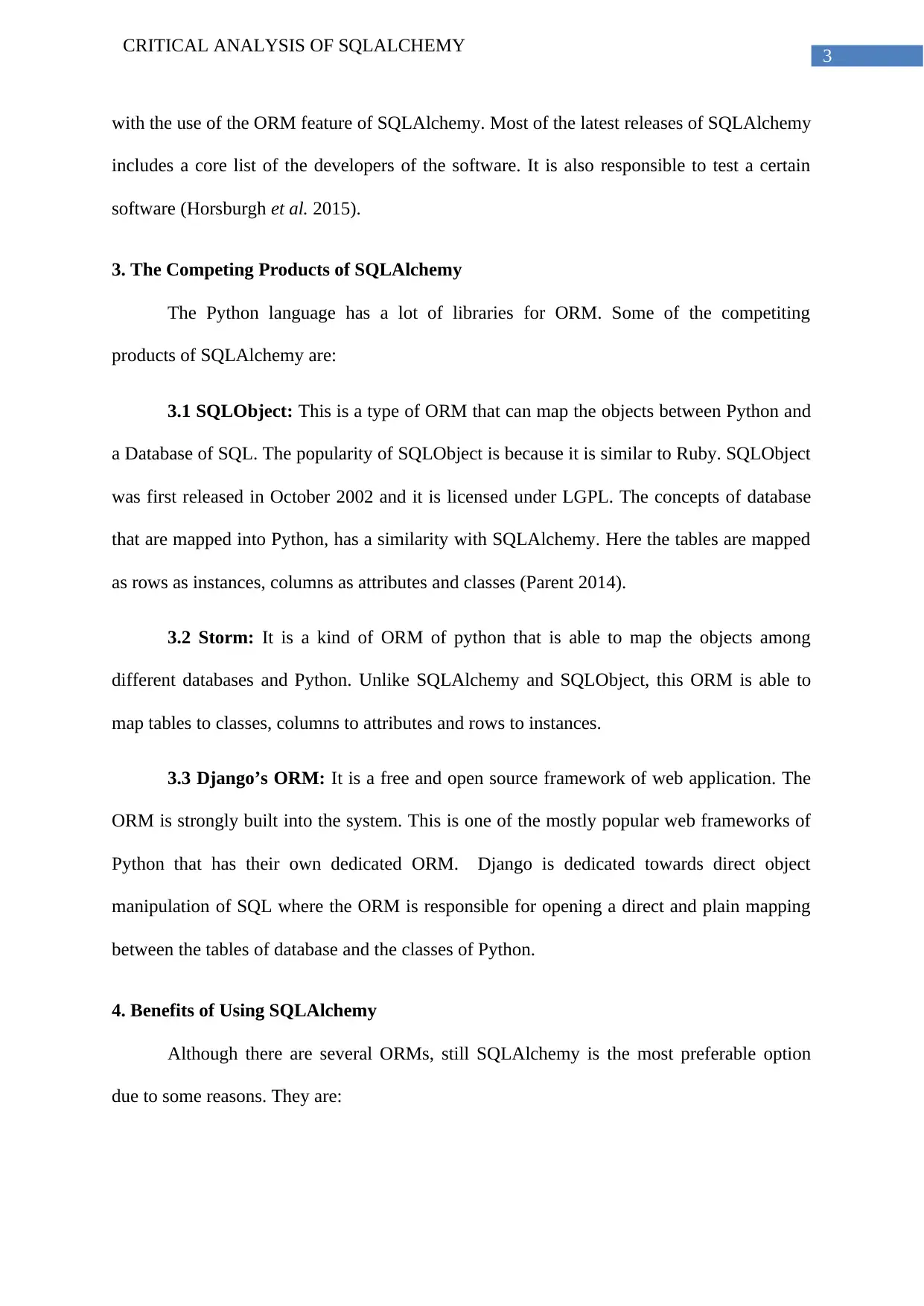
3
CRITICAL ANALYSIS OF SQLALCHEMY
with the use of the ORM feature of SQLAlchemy. Most of the latest releases of SQLAlchemy
includes a core list of the developers of the software. It is also responsible to test a certain
software (Horsburgh et al. 2015).
3. The Competing Products of SQLAlchemy
The Python language has a lot of libraries for ORM. Some of the competiting
products of SQLAlchemy are:
3.1 SQLObject: This is a type of ORM that can map the objects between Python and
a Database of SQL. The popularity of SQLObject is because it is similar to Ruby. SQLObject
was first released in October 2002 and it is licensed under LGPL. The concepts of database
that are mapped into Python, has a similarity with SQLAlchemy. Here the tables are mapped
as rows as instances, columns as attributes and classes (Parent 2014).
3.2 Storm: It is a kind of ORM of python that is able to map the objects among
different databases and Python. Unlike SQLAlchemy and SQLObject, this ORM is able to
map tables to classes, columns to attributes and rows to instances.
3.3 Django’s ORM: It is a free and open source framework of web application. The
ORM is strongly built into the system. This is one of the mostly popular web frameworks of
Python that has their own dedicated ORM. Django is dedicated towards direct object
manipulation of SQL where the ORM is responsible for opening a direct and plain mapping
between the tables of database and the classes of Python.
4. Benefits of Using SQLAlchemy
Although there are several ORMs, still SQLAlchemy is the most preferable option
due to some reasons. They are:
CRITICAL ANALYSIS OF SQLALCHEMY
with the use of the ORM feature of SQLAlchemy. Most of the latest releases of SQLAlchemy
includes a core list of the developers of the software. It is also responsible to test a certain
software (Horsburgh et al. 2015).
3. The Competing Products of SQLAlchemy
The Python language has a lot of libraries for ORM. Some of the competiting
products of SQLAlchemy are:
3.1 SQLObject: This is a type of ORM that can map the objects between Python and
a Database of SQL. The popularity of SQLObject is because it is similar to Ruby. SQLObject
was first released in October 2002 and it is licensed under LGPL. The concepts of database
that are mapped into Python, has a similarity with SQLAlchemy. Here the tables are mapped
as rows as instances, columns as attributes and classes (Parent 2014).
3.2 Storm: It is a kind of ORM of python that is able to map the objects among
different databases and Python. Unlike SQLAlchemy and SQLObject, this ORM is able to
map tables to classes, columns to attributes and rows to instances.
3.3 Django’s ORM: It is a free and open source framework of web application. The
ORM is strongly built into the system. This is one of the mostly popular web frameworks of
Python that has their own dedicated ORM. Django is dedicated towards direct object
manipulation of SQL where the ORM is responsible for opening a direct and plain mapping
between the tables of database and the classes of Python.
4. Benefits of Using SQLAlchemy
Although there are several ORMs, still SQLAlchemy is the most preferable option
due to some reasons. They are:
Paraphrase This Document
Need a fresh take? Get an instant paraphrase of this document with our AI Paraphraser
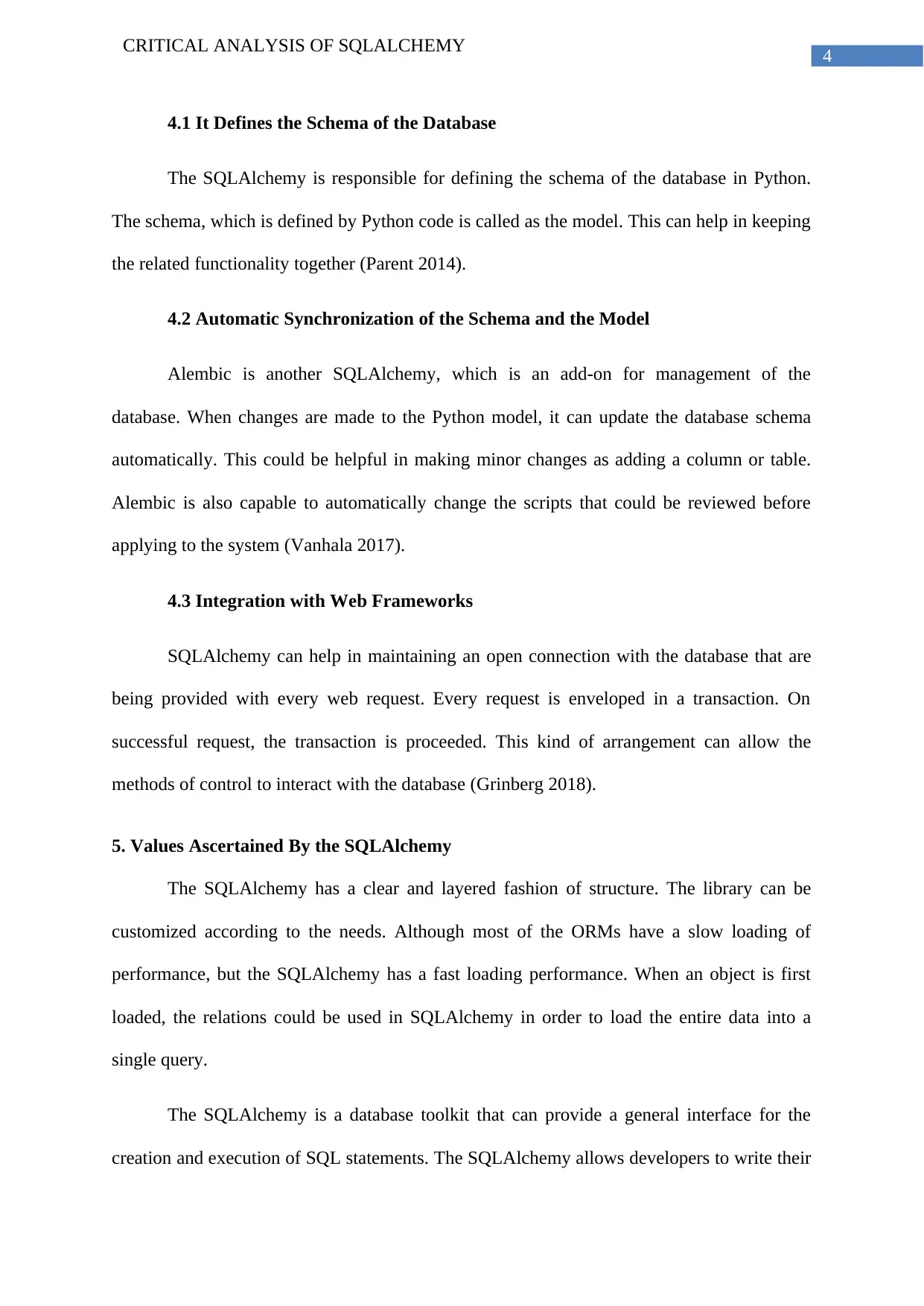
4
CRITICAL ANALYSIS OF SQLALCHEMY
4.1 It Defines the Schema of the Database
The SQLAlchemy is responsible for defining the schema of the database in Python.
The schema, which is defined by Python code is called as the model. This can help in keeping
the related functionality together (Parent 2014).
4.2 Automatic Synchronization of the Schema and the Model
Alembic is another SQLAlchemy, which is an add-on for management of the
database. When changes are made to the Python model, it can update the database schema
automatically. This could be helpful in making minor changes as adding a column or table.
Alembic is also capable to automatically change the scripts that could be reviewed before
applying to the system (Vanhala 2017).
4.3 Integration with Web Frameworks
SQLAlchemy can help in maintaining an open connection with the database that are
being provided with every web request. Every request is enveloped in a transaction. On
successful request, the transaction is proceeded. This kind of arrangement can allow the
methods of control to interact with the database (Grinberg 2018).
5. Values Ascertained By the SQLAlchemy
The SQLAlchemy has a clear and layered fashion of structure. The library can be
customized according to the needs. Although most of the ORMs have a slow loading of
performance, but the SQLAlchemy has a fast loading performance. When an object is first
loaded, the relations could be used in SQLAlchemy in order to load the entire data into a
single query.
The SQLAlchemy is a database toolkit that can provide a general interface for the
creation and execution of SQL statements. The SQLAlchemy allows developers to write their
CRITICAL ANALYSIS OF SQLALCHEMY
4.1 It Defines the Schema of the Database
The SQLAlchemy is responsible for defining the schema of the database in Python.
The schema, which is defined by Python code is called as the model. This can help in keeping
the related functionality together (Parent 2014).
4.2 Automatic Synchronization of the Schema and the Model
Alembic is another SQLAlchemy, which is an add-on for management of the
database. When changes are made to the Python model, it can update the database schema
automatically. This could be helpful in making minor changes as adding a column or table.
Alembic is also capable to automatically change the scripts that could be reviewed before
applying to the system (Vanhala 2017).
4.3 Integration with Web Frameworks
SQLAlchemy can help in maintaining an open connection with the database that are
being provided with every web request. Every request is enveloped in a transaction. On
successful request, the transaction is proceeded. This kind of arrangement can allow the
methods of control to interact with the database (Grinberg 2018).
5. Values Ascertained By the SQLAlchemy
The SQLAlchemy has a clear and layered fashion of structure. The library can be
customized according to the needs. Although most of the ORMs have a slow loading of
performance, but the SQLAlchemy has a fast loading performance. When an object is first
loaded, the relations could be used in SQLAlchemy in order to load the entire data into a
single query.
The SQLAlchemy is a database toolkit that can provide a general interface for the
creation and execution of SQL statements. The SQLAlchemy allows developers to write their
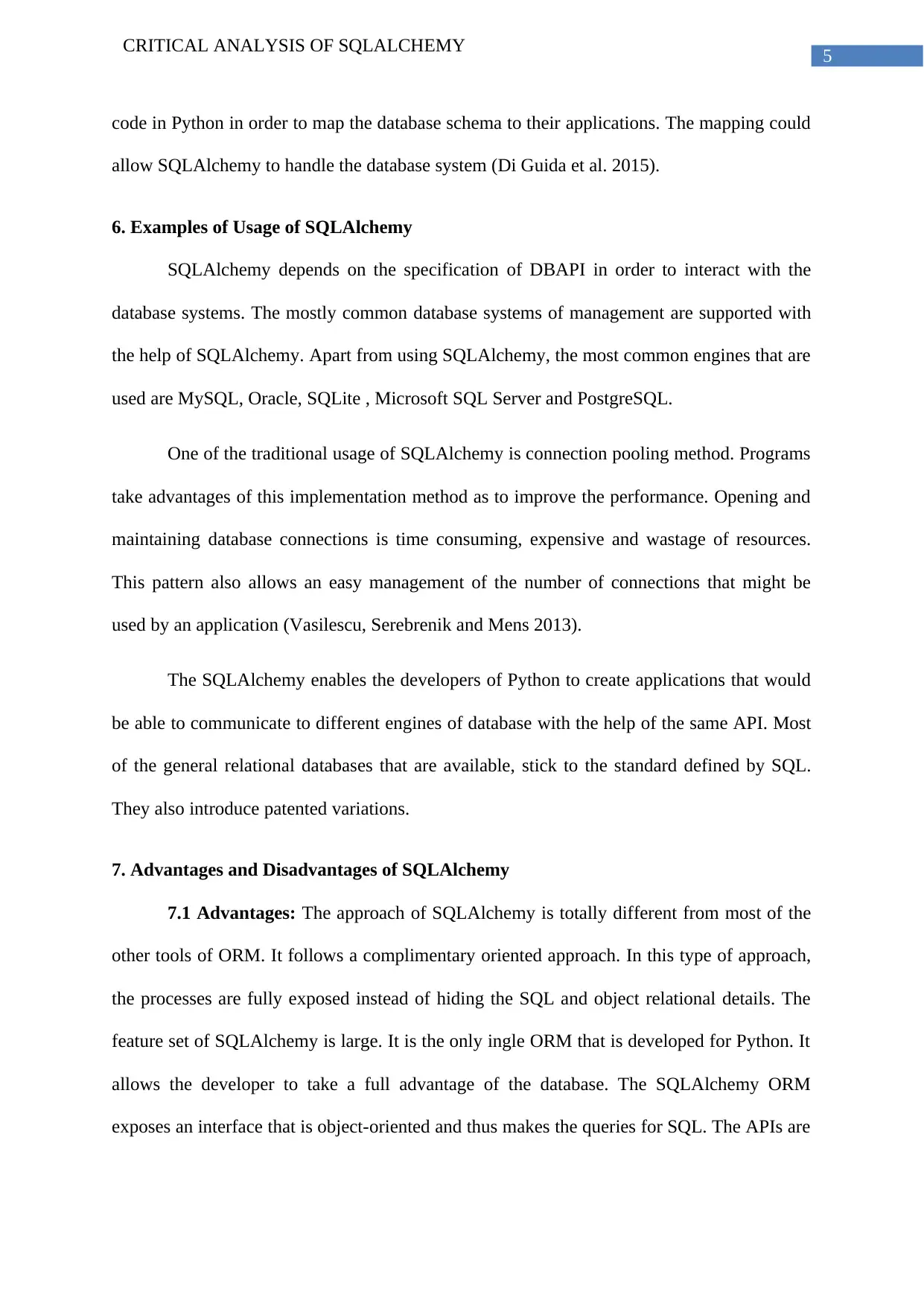
5
CRITICAL ANALYSIS OF SQLALCHEMY
code in Python in order to map the database schema to their applications. The mapping could
allow SQLAlchemy to handle the database system (Di Guida et al. 2015).
6. Examples of Usage of SQLAlchemy
SQLAlchemy depends on the specification of DBAPI in order to interact with the
database systems. The mostly common database systems of management are supported with
the help of SQLAlchemy. Apart from using SQLAlchemy, the most common engines that are
used are MySQL, Oracle, SQLite , Microsoft SQL Server and PostgreSQL.
One of the traditional usage of SQLAlchemy is connection pooling method. Programs
take advantages of this implementation method as to improve the performance. Opening and
maintaining database connections is time consuming, expensive and wastage of resources.
This pattern also allows an easy management of the number of connections that might be
used by an application (Vasilescu, Serebrenik and Mens 2013).
The SQLAlchemy enables the developers of Python to create applications that would
be able to communicate to different engines of database with the help of the same API. Most
of the general relational databases that are available, stick to the standard defined by SQL.
They also introduce patented variations.
7. Advantages and Disadvantages of SQLAlchemy
7.1 Advantages: The approach of SQLAlchemy is totally different from most of the
other tools of ORM. It follows a complimentary oriented approach. In this type of approach,
the processes are fully exposed instead of hiding the SQL and object relational details. The
feature set of SQLAlchemy is large. It is the only ingle ORM that is developed for Python. It
allows the developer to take a full advantage of the database. The SQLAlchemy ORM
exposes an interface that is object-oriented and thus makes the queries for SQL. The APIs are
CRITICAL ANALYSIS OF SQLALCHEMY
code in Python in order to map the database schema to their applications. The mapping could
allow SQLAlchemy to handle the database system (Di Guida et al. 2015).
6. Examples of Usage of SQLAlchemy
SQLAlchemy depends on the specification of DBAPI in order to interact with the
database systems. The mostly common database systems of management are supported with
the help of SQLAlchemy. Apart from using SQLAlchemy, the most common engines that are
used are MySQL, Oracle, SQLite , Microsoft SQL Server and PostgreSQL.
One of the traditional usage of SQLAlchemy is connection pooling method. Programs
take advantages of this implementation method as to improve the performance. Opening and
maintaining database connections is time consuming, expensive and wastage of resources.
This pattern also allows an easy management of the number of connections that might be
used by an application (Vasilescu, Serebrenik and Mens 2013).
The SQLAlchemy enables the developers of Python to create applications that would
be able to communicate to different engines of database with the help of the same API. Most
of the general relational databases that are available, stick to the standard defined by SQL.
They also introduce patented variations.
7. Advantages and Disadvantages of SQLAlchemy
7.1 Advantages: The approach of SQLAlchemy is totally different from most of the
other tools of ORM. It follows a complimentary oriented approach. In this type of approach,
the processes are fully exposed instead of hiding the SQL and object relational details. The
feature set of SQLAlchemy is large. It is the only ingle ORM that is developed for Python. It
allows the developer to take a full advantage of the database. The SQLAlchemy ORM
exposes an interface that is object-oriented and thus makes the queries for SQL. The APIs are
⊘ This is a preview!⊘
Do you want full access?
Subscribe today to unlock all pages.

Trusted by 1+ million students worldwide
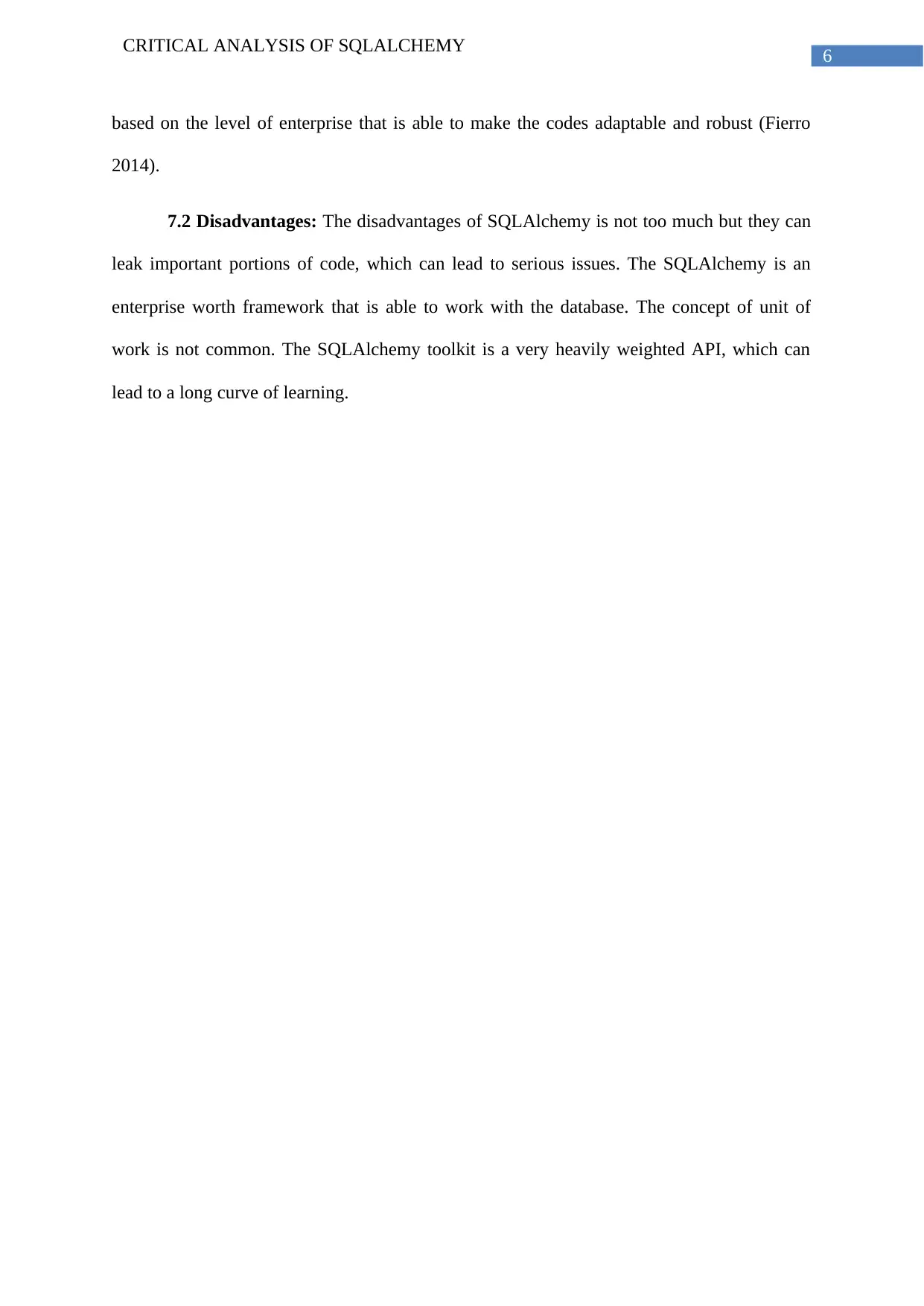
6
CRITICAL ANALYSIS OF SQLALCHEMY
based on the level of enterprise that is able to make the codes adaptable and robust (Fierro
2014).
7.2 Disadvantages: The disadvantages of SQLAlchemy is not too much but they can
leak important portions of code, which can lead to serious issues. The SQLAlchemy is an
enterprise worth framework that is able to work with the database. The concept of unit of
work is not common. The SQLAlchemy toolkit is a very heavily weighted API, which can
lead to a long curve of learning.
CRITICAL ANALYSIS OF SQLALCHEMY
based on the level of enterprise that is able to make the codes adaptable and robust (Fierro
2014).
7.2 Disadvantages: The disadvantages of SQLAlchemy is not too much but they can
leak important portions of code, which can lead to serious issues. The SQLAlchemy is an
enterprise worth framework that is able to work with the database. The concept of unit of
work is not common. The SQLAlchemy toolkit is a very heavily weighted API, which can
lead to a long curve of learning.
Paraphrase This Document
Need a fresh take? Get an instant paraphrase of this document with our AI Paraphraser
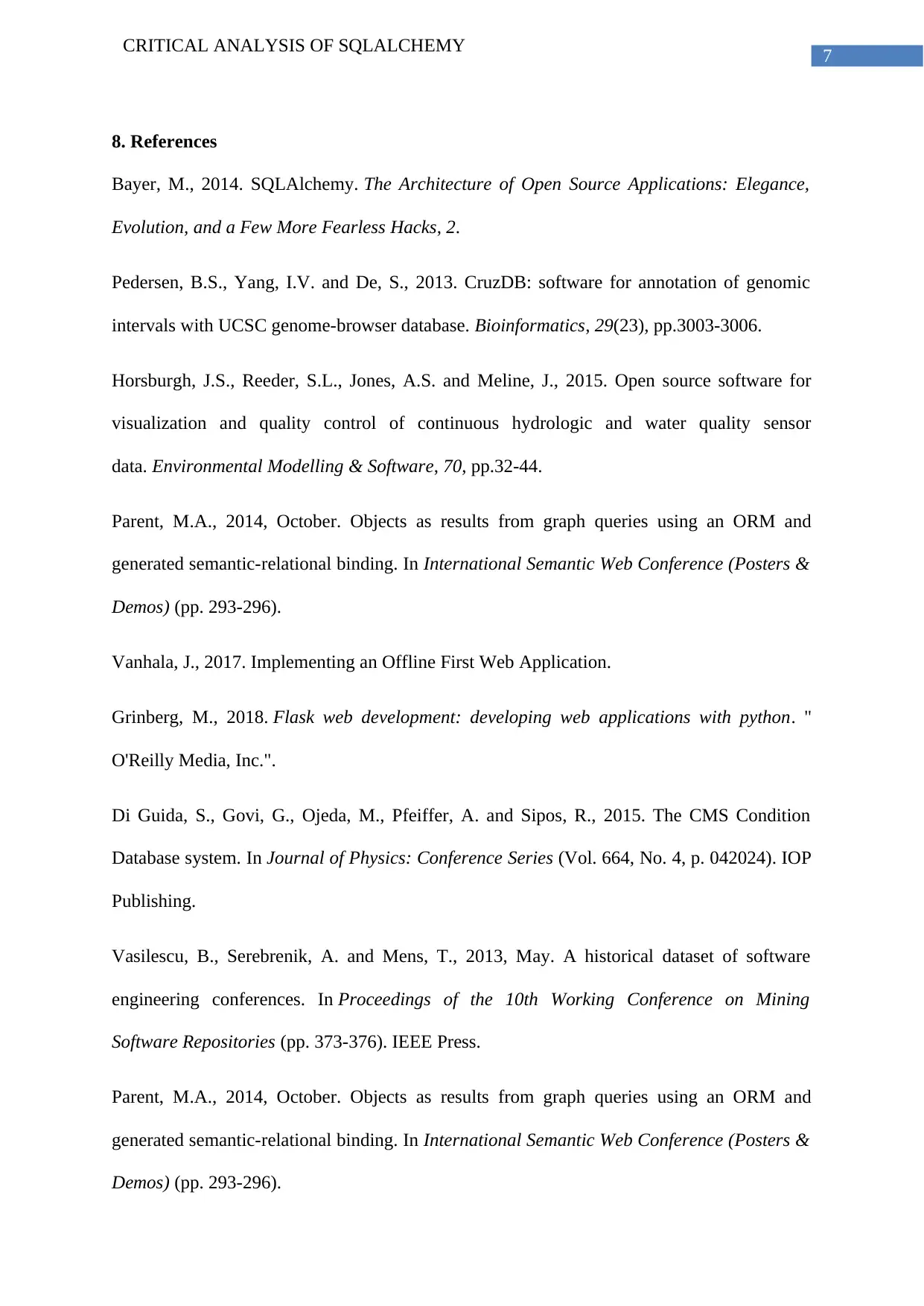
7
CRITICAL ANALYSIS OF SQLALCHEMY
8. References
Bayer, M., 2014. SQLAlchemy. The Architecture of Open Source Applications: Elegance,
Evolution, and a Few More Fearless Hacks, 2.
Pedersen, B.S., Yang, I.V. and De, S., 2013. CruzDB: software for annotation of genomic
intervals with UCSC genome-browser database. Bioinformatics, 29(23), pp.3003-3006.
Horsburgh, J.S., Reeder, S.L., Jones, A.S. and Meline, J., 2015. Open source software for
visualization and quality control of continuous hydrologic and water quality sensor
data. Environmental Modelling & Software, 70, pp.32-44.
Parent, M.A., 2014, October. Objects as results from graph queries using an ORM and
generated semantic-relational binding. In International Semantic Web Conference (Posters &
Demos) (pp. 293-296).
Vanhala, J., 2017. Implementing an Offline First Web Application.
Grinberg, M., 2018. Flask web development: developing web applications with python. "
O'Reilly Media, Inc.".
Di Guida, S., Govi, G., Ojeda, M., Pfeiffer, A. and Sipos, R., 2015. The CMS Condition
Database system. In Journal of Physics: Conference Series (Vol. 664, No. 4, p. 042024). IOP
Publishing.
Vasilescu, B., Serebrenik, A. and Mens, T., 2013, May. A historical dataset of software
engineering conferences. In Proceedings of the 10th Working Conference on Mining
Software Repositories (pp. 373-376). IEEE Press.
Parent, M.A., 2014, October. Objects as results from graph queries using an ORM and
generated semantic-relational binding. In International Semantic Web Conference (Posters &
Demos) (pp. 293-296).
CRITICAL ANALYSIS OF SQLALCHEMY
8. References
Bayer, M., 2014. SQLAlchemy. The Architecture of Open Source Applications: Elegance,
Evolution, and a Few More Fearless Hacks, 2.
Pedersen, B.S., Yang, I.V. and De, S., 2013. CruzDB: software for annotation of genomic
intervals with UCSC genome-browser database. Bioinformatics, 29(23), pp.3003-3006.
Horsburgh, J.S., Reeder, S.L., Jones, A.S. and Meline, J., 2015. Open source software for
visualization and quality control of continuous hydrologic and water quality sensor
data. Environmental Modelling & Software, 70, pp.32-44.
Parent, M.A., 2014, October. Objects as results from graph queries using an ORM and
generated semantic-relational binding. In International Semantic Web Conference (Posters &
Demos) (pp. 293-296).
Vanhala, J., 2017. Implementing an Offline First Web Application.
Grinberg, M., 2018. Flask web development: developing web applications with python. "
O'Reilly Media, Inc.".
Di Guida, S., Govi, G., Ojeda, M., Pfeiffer, A. and Sipos, R., 2015. The CMS Condition
Database system. In Journal of Physics: Conference Series (Vol. 664, No. 4, p. 042024). IOP
Publishing.
Vasilescu, B., Serebrenik, A. and Mens, T., 2013, May. A historical dataset of software
engineering conferences. In Proceedings of the 10th Working Conference on Mining
Software Repositories (pp. 373-376). IEEE Press.
Parent, M.A., 2014, October. Objects as results from graph queries using an ORM and
generated semantic-relational binding. In International Semantic Web Conference (Posters &
Demos) (pp. 293-296).
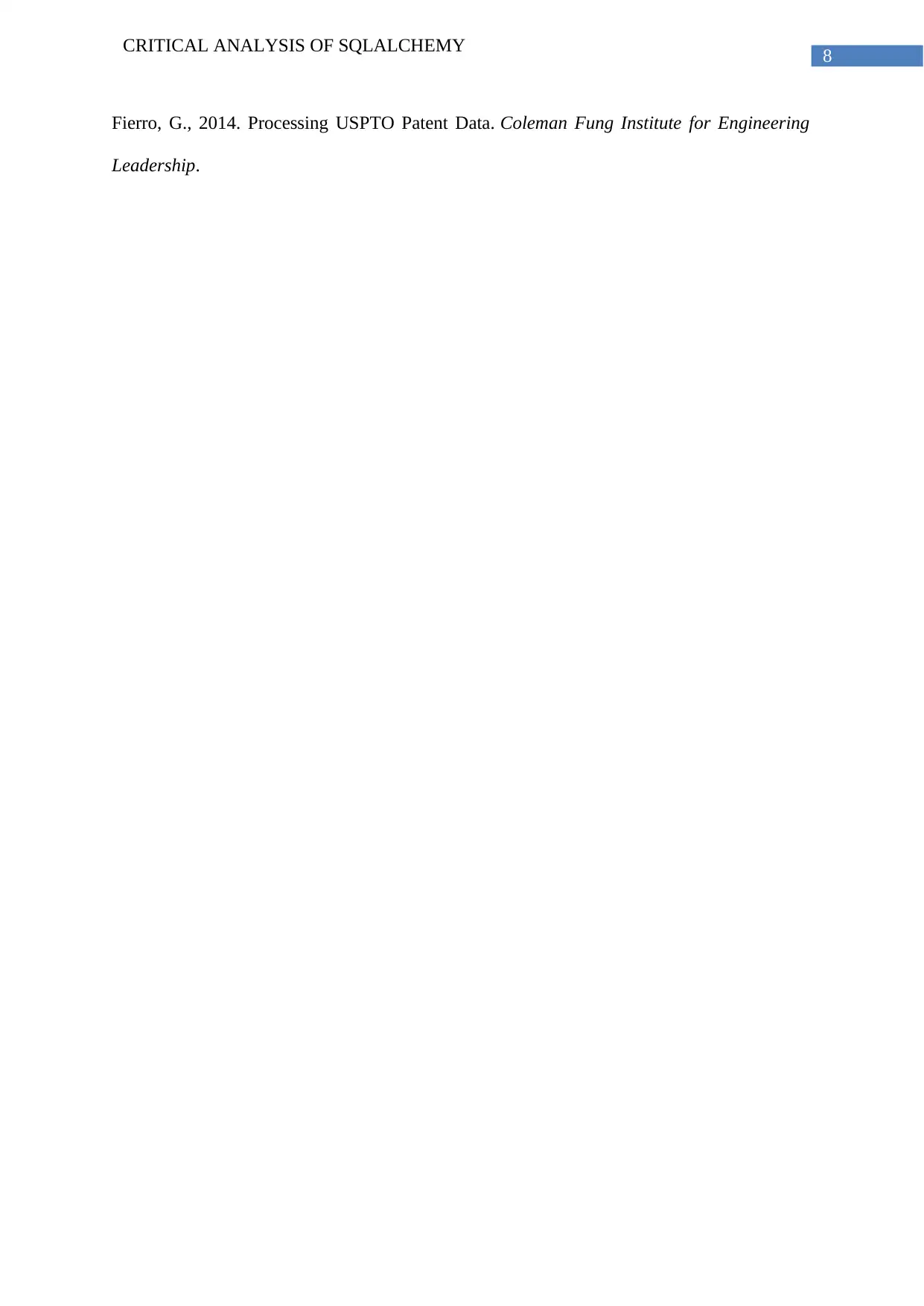
8
CRITICAL ANALYSIS OF SQLALCHEMY
Fierro, G., 2014. Processing USPTO Patent Data. Coleman Fung Institute for Engineering
Leadership.
CRITICAL ANALYSIS OF SQLALCHEMY
Fierro, G., 2014. Processing USPTO Patent Data. Coleman Fung Institute for Engineering
Leadership.
⊘ This is a preview!⊘
Do you want full access?
Subscribe today to unlock all pages.

Trusted by 1+ million students worldwide
1 out of 9
Related Documents
Your All-in-One AI-Powered Toolkit for Academic Success.
+13062052269
info@desklib.com
Available 24*7 on WhatsApp / Email
![[object Object]](/_next/static/media/star-bottom.7253800d.svg)
Unlock your academic potential
Copyright © 2020–2025 A2Z Services. All Rights Reserved. Developed and managed by ZUCOL.





